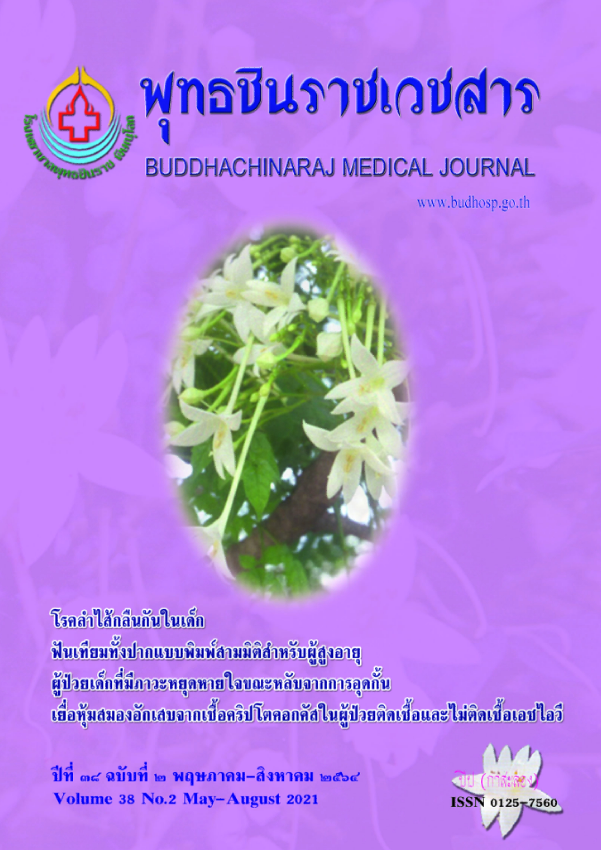ผลของโปรแกรมควบคุมการใช้ยาต้านจุลชีพ ต่อความเหมาะสมของการใช้ยาต้านจุลชีพ
ความเหมาะสมของการใช้ยาต้านจุลชีพ
คำสำคัญ:
โปรแกรมควบคุมการใช้ยาต้านจุลชีพ, ความเหมาะสมของการใช้ยาต้านจุลชีพ, เภสัชกรบทคัดย่อ
ปัญหาเชื้อก่อโรคดื้อยาต้านจุลชีพเป็นปัญหาต่อระบบสุขภาพทั่วโลก การศึกษากึ่งทดลองครั้งนี้มีวัตถุประสงค์เพื่อเปรียบเทียบ ความเหมาะสมของการใช้ยาและปริมาณการใช้ยา piperacillin/tazobactam และ meropenem ระหว่างก่อนและหลังใช้ โปรแกรมควบคุมการใช้ยาต้านจุลชีพ โดยศึกษาในผู้ป่วยที่ได้ใช้ยาเหล่านี้ในช่วงก่อนใช้โปรแกรมฯ (1 กันยายน พ.ศ. 2562 ถึง 28 กุมภาพันธ์ พ.ศ. 2563) และช่วงหลังใช้โปรแกรมฯ (1 กันยายน พ.ศ. 2563 ถึง 28 กุมภาพันธ์ พ.ศ. 2564) โปรแกรมฯ ประกอบด้วย การให้ความรู้และการนำแนวทางการใช้ยาตามโปรแกรมมาจัดทำเกณฑ์ประเมินการใช้ยาโดยเภสัชกรประเมินความเหมาะสมของ การใช้ยาและแจ้งข้อมูลแก่แพทย์หากพบการสั่งใช้ยาไม่เหมาะสม พบว่าก่อนและหลังใช้โปรแกรมฯ มีผู้ป่วยที่ได้ใช้ยาดังกล่าว 1,851 รายและ1,994 รายตามลำดับ พบการสั่งใช้ยาเหมาะสมร้อยละ 96.1 และร้อยละ 90.1 ตามลำดับ (p < 0.001) พบการสั่งใช้ ยาไม่เหมาะสมเพิ่มจาก 73 ครั้ง (ร้อยละ 3.9) เป็น 198 ครั้ง (ร้อยละ 9.9) (p < 0.001) และแพทย์เปลี่ยนคำสั่งใช้ยาหลังได้รับคำ แนะนำจากเภสัชกร 47 ครั้ง (ร้อยละ 64.4) และ 108 ครั้ง (ร้อยละ 54.5) ตามลำดับ โดยหลังใช้โปรแกรมฯ แพทย์ปรับขนาดยาต้าน จุลชีพร้อยละ 44.9 อีกทั้งพบว่าปริมาณการใช้ยาในรูปแบบยากำหนด DDD/1,000 วันนอน ของยาpiperacillin/tazobactam ลดลง ขณะที่ปริมาณการใช้ยา meropenem เพิ่มขึ้นอย่างมีนัยสำคัญทางสถิติ (p < 0.001) สรุปได้ว่าการใช้โปรแกรมนี้มีส่วนช่วย ให้การสั่งใช้ยาต้านจุลชีพสมเหตุผลมากขึ้นโดยเฉพาะขนาดยา ที่ไม่เหมาะสม แต่ปริมาณการใช้ยาต้านจุลชีพในภาพรวมไม่ลดลง
เอกสารอ้างอิง
2. Kanoksil M, Jatapai A, Peacock SJ, Limmathurotsakul D. Epidermiology, microbiology and mortality associated with community acquired bacteremia in northeast Thailand: a multicenter surveillance study. PLoS One 2013;8(1):e54714. doi:10.1371/journal.pone.0054714
3. Huttner A, Harbarth S, Carlet J, Cosgrove S, Goossens H, Holmes A, et al. Antimicrobial resistance: a global view from the 2013 World Healthcare-Associated Infections Forum. Antimicrob Resist Infect Control 2013;2(1):31. doi:10.1186/2047-2994-2-31.
4. Ventola CL. The antibiotic resistance crisis.part 1: causes and threats. PT 2015;40(4 Pt1):277-83.
5. World Health Organization. Antibiotic resistance [Internet]. 2020 [cited2020 May 17]. Available from: URL: http://www.who.int/mediacentre/factsheets/antibiotic-resistance/en/
6. Phumart P, Phodha T, Thamlikitkul V, Riewpaiboon A, Prakongsai P, Limwattananon S. Health and economic impacts of antimicrobial resistant infections in Thailand: a preliminary study. J Health Syst Res 2012;6(3):352-60.
7. Van Boeckel TP, Gandra S, Ashok A, Caudron Q, Grenfell BT, Levin SA, et al. Global antibiotic consumption 2000 to 2010: an analysisof national pharmaceutical sales data. LancetInfect Dis2014;14(8): 742-50.
8. National Antimicrobial Resistance Surveillance Center. Top ten isolates [Internet]. 2020 [updated 2020 April 4; cited 2020 May 17]. Available from: URL:http://narst.dmsc.moph. go.th/a7.php
9. Office of the Permanent Secretary. Ministry of Public Health. Self assessment for Integrated AMR Management System. Bangkok, Thailand: Health Administration Division; 2018.
10. Apisarnthanarak A, Danchaivijitr S, Khawcharoenporn T, Limsrivilai J, Warachan B, Bailey TC, et al. Effectiveness of education and an antibiotic-control program in a tertiary care hospital in Thailand. Clin Infect Dis 2006;42(6):768-75.
11. Phaliphot V, Chittawattanarat K, Ruengorn C, Lucksiri A. Effects of antibiotic restriction program in critical care surgery patients at Maharaj Nakorn Chiang Mai Hospital. Thai Pharm Health Sci J 2015;10(2):59-66.
12. Prapokklao Hospital. Meeting of the Antimicrobial Stewardship Committee 1st 2019; 2019 Nov 12; Prapokklao Hospital, Chanthaburi.
13. World Health Organization. The evolving threat of antimicrobial resistance: options for action. Geneva, Switzerland: WHO; 2012.
14. Kiratisin P, Chongthaleong A, Tan TY, Lagamayo E, Roberts S, Garcia J, et al. Comparative in vitro activity of carbapenems against major Gram-negative pathogens: results of Asia-Pacific Surveillance from the COMPACT II Study. Int J Antimicrob Agents 2012;39(4):311-6.
15. Khalil F, Laer S. Physiologically based pharmacokinetic modeling: methodology, applications, and limitations with a focus on its role in pediatric drug development. J Biomed Biotechnol 2011;2011:907461. doi:10.1155/2011/907461
16. Niwa T, Shinoda Y, Suzuki A, Ohmori T, Yasuda M, Ohta H, et al. Outcome measurement of extensive implementation of antimicrobial stewardship in patients receiving intravenous antibiotics in a Japanese university hospital. Int J Clin Pract 2012;66(10):999-1008.
17. Thipmontri W. Antimicrobial Stewardship Program Maharat Nakhonratchasima Hospital. In: Thipmontri W, Wiwatrojanakul S, Promthanjai K, editors. Bangkok, Thailand: Agricultural Cooperative Association of Thailand Printing House: 2018. p.54-6.
18. Ananwattanakit M, Usayaporn S, Tantawichien T, Puttilerpong C, Pengsuparp T. Effects of pharmacist participation in an Antimicrobial Stewardship Program on appropriate antibiotic use. Thai Pharm Health Sci J 2015;10(1):1-9.
19. Ungsamran K. Antimicrobial stewardship: among carbapenems, tigecyline at Department of Medicine. Mahasarakham Hosp J 2018;15(2):23-33.
20. Mahmoudi L, Sepasian A, Firouzabadi D, Akbari A. The impact of an Antibiotic Stewardship Program on the consumption of specific antimicrobials and their cost burden: a hospital-wide intervention. Risk Manag Healthc Policy 2020;13:1701-9.doi: 10.2147/RMHP.S265407
21. Chaiyasong C, Tiyapak P, Pinake S, Chaiyasong S. Associations between antibiotic use and resistance in Mahasarakham Hospital. IJPS 2019;15(2):98-105.
22. Stultz JS, Arnold SR, Shelton CM, Bagga B, Lee KR. Antimicrobial stowardship impact on Pseudomonas aeruginosa susceptibility to meropenem at a tertiary pediatric institution. Am J Infect Control 2019;47(12):1513-5.






